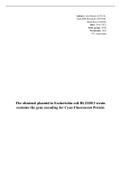Authors: Arzu Burak (2635213),
Asma Riffi Moutayeb (2697038),
Hirad Rasi (2704296)
Date: 28-02-2021
Tutor group: 19/20
Wordcount: 3629
VU, Amsterdam
The obtained plasmid in Escherichia coli BL21DE3 strain
contains the gene encoding for Cyan Fluorescent Protein
,ABSTRACT
Fluorescent proteins are widely used in contemporary cell biological and biotechnological research.
These proteins are mainly used to investigate certain parts of cells, such as periplasmic and
cytoplasmic proteins. Green fluorescent protein (GFP), red fluorescent protein (mCherry), yellow
fluorescent protein (YFP), and cyan fluorescent protein (CFP) are proteins that can be used as
biological markers to observe cellular processes and gene expressions. This study analyzed the
different characteristics of the earlier mentioned fluorescent proteins by receiving an E. coli Top10
strain containing the pET-16B plasmid, which has a gene encoding for one of the fluorescent proteins.
This plasmid was then inserted into an E. coli BL21DE2 strain. The purpose of this experiment is to
determine whether the gene of an obtained plasmid encodes for GFP, mCherry, YFP, or CFP. The
banding pattern of the examined plasmid was first analyzed by use of DNA-restriction analysis. The
banding pattern resulted in 3000, 2000, 1000, and 400 base pairs. After this, the molecular weight,
absorption, and emission spectra were measured. The determined molecular weight was 28.8 kDa
(figure 4) and the excitation wavelength determined with the absorption spectrum was 440 nm (figure
7). The absorption spectrum was used to determine the wavelength at whichever the protein started to
emit light, which was 475 nm (figure 6). Results corresponded with the spectra of CFP. Therefore, all
obtained results show that the BL21DE3 strain in E. coli encodes for CFP.
, INTRODUCTION
Green fluorescent protein was discovered by Shimomura in 1962 (Shimomura et al., 1962). This
protein was first derived from the Aequorea victoria jellyfish. The green fluorescent protein is made
of 238 amino acids which can be used as a cellular tag. According to research executed by Ansari et
al., (2016), only 4 of these amino acids will give the protein its fluorescent characteristics. As these
proteins can not only be green, but also mCherry, cyan, and yellow, they are very diverse. The
properties of the GFP are officially derived from the luminous jellyfish called Aequorea victoria.
Currently, GFP helps the scientific world a lot with measuring gene cell tracking and gene expression.
Another study conducted by Kubala et al., (2010) showed that the structure of GFP consists of a
single central alpha-helix, which is embedded by eleven β-strands (figure 1). Each strand is composed
of nine to thirteen residues. This construction forms a β-barrel. The alpha-helix forms the
chromophore by cyclization of Gly67, Tyr66, and Ser65. Mutation can destroy the fluorescence of the
GFP. The chromophore needs to be protected by the β-barrel to avoid a change in structure (Chalfie et
al., 1994).
The GFP has several functions in organisms. Some of these functions are acting as a fusion tag or as a
reporter gene and functioning as a Fluorescence Resonance Energy transfer (FRET). The fusion tag
has the role to frame the location of the protein. Moreover, the fusion tag can show the dynamic
cellular events. Gene expression can also be monitored with the help of a GFP gene, which is
controlled by a promoter. FRET is involved with the change in the peptide sequence. Eventually, GFP
is a marker for tumor cells to illustrate the progression of tumor growth (Zimmer, 2002). Each
fluorescent protein has its emission wavelength, this is a cause of the structural difference in the
fluorescent protein. Each emission wavelength is linked to a unique fluorescent property (Figure 2),
which could lead to a difference in color. This distinction is caused by the structural difference of the
fluorescence protein. Every separate protein contains a quantum yield, responsible for emission
efficiency of the protein which is afflicted by the stability and folding of the protein. The electrons
around the chromophore have also a great influence on the emission efficiency. A study conducted by
Aliye et al., (2015) concluded that a mutation affects the amino acid sequence. This will lead to a
change in the structure of the protein. The protein structure will directly influence the emission
efficiency and absorption of the fluorophore, which could lead to a difference in color (Aliye et al.,
2015).
This report aims to identify which fluorescence protein is coded by the gene on the plasmid in the
bacterial strain. This will be examined by experiments on both DNA level and protein level. First, a
DNA restriction analysis is carried out. Finally, the molecular weight, absorption, and emission are
determined on the protein level.





